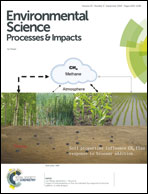Contrasting effects of bioturbation on metal toxicity of contaminated sediments results in misleading interpretation of the AVS–SEM metal-sulfide paradigm†
Abstract
In undisturbed, metal-contaminated marine sediments, porewater metal concentrations are generally low due to their associations with strong binding phases such as organic matter, Fe/Mn (oxy)hydroxides and sulfides. Bioturbating fauna can alter redox conditions and, therefore, metal binding, potentially leading to increased metal bioavailability and subsequent toxicity to inhabiting organisms. Here we assessed the impacts of bioturbation (by bivalves and large amphipod species) on sediment biogeochemistry, metal bioaccumulation and toxicity to a smaller amphipod species in a metal contaminated sediment with low and high acid volatile sulfide (AVS) concentrations. Active bioturbation lowered metal toxicity to reproduction in the sediment with low-AVS (from 90% toxic (non-bioturbated) to 50% toxic (bioturbated)). This corresponded with lower dissolved metal concentrations in the overlying water column and lower metal bioaccumulation. Conversely, toxicity increased due to bioturbation in the sediment with high-AVS (40% toxic (non-bioturbated) to 80% toxic (bioturbated)), coinciding with sulfide oxidation, metal release and greater metal bioaccumulation. The results indicate that the AVS–SEM paradigm (commonly used to estimate the risks of adverse effects to benthic organisms in metal-contaminated sediments) may result in incorrect assessment outcomes in cases where bioturbating organisms rework and oxidize the sediment, or for those sediments where AVS has accumulated due to the inability of larger bioturbating benthic organisms to establish populations.



 Please wait while we load your content...
Please wait while we load your content...